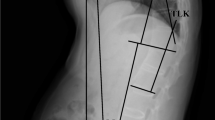Abstract
Purpose
Little information is available on the relationship between cervical sagittal alignment and health-related quality of life (HRQOL) in ankylosing spondylitis (AS) patients. The aim of this study was to identify relationships between cervical sagittal alignment and HRQOL in AS.
Methods
The study and control groups comprised 102 AS patients (15 women and 87 men) and age- and sex-matched 50 controls, respectively. All underwent anteroposterior and lateral radiographs and completed clinical questionnaires. The radiographic parameters examined were C2–C7 lordosis, C2–C7 sagittal vertical axis (SVA), T1 slope and T1 slope minus C2–C7 lordosis (TS-CL). A visual analogue scale (VAS 0–10) score for neck pain, the neck disability index (NDI), neck pain and disability (NPAD) scale and bath ankylosing spondylitis disease activity index (BASDAI) were administered to evaluate QOL. Statistical analysis was performed to determine the significances of differences between the study and control groups. In addition, correlations between radiological parameters and clinical questionnaires were sought.
Results
AS patients and controls were found to be different significantly in terms of C2–C7 SVA, T1 slope, and TS-CL. However, no significant intergroup difference was observed for C2–C7 lordosis (P > 0.05). Correlation analysis revealed significant relationships between radiographic parameters and QOL. Multiple regression analysis was performed to identify predictors of QOL, and the results obtained revealed that C2–C7 SVA significantly predicted VAS, NDI, and NPAD scores and that age predicted NPAD score.
Conclusions
Cervical sagittal parameters were found to be significantly different in AS patients and normal controls. Correlation analysis revealed significant relationships between radiographic parameters and QOL. In particular, C2–C7 SVA was found to be a significant predictor of QOL in AS patient.


Similar content being viewed by others
References
Belanger TA, Milam RA 4th, Roh JS, Bohlman HH (2005) Cervicothoracic extension osteotomy for chin-on-chest deformity in ankylosing spondylitis. J Bone Jt Surg Am 87:1732–1738
Boulay C, Tardieu C, Hecquet J, Benaim C, Mouilleseaux B, Marty C, Prat-Pradal D, Legaye J, Duval-Beaupère G, Pélissier J (2006) Sagittal alignment of spine and pelvis regulated by pelvic incidence: standard values and prediction of lordosis. Eur Spine J 15:415–422
Calin A, Garrett S, Whitelock H, Kennedy LG, O’Hea J, Mallorie P, Jenkinson T (1994) A new approach to defining functional ability in ankylosing spondylitis: the development of the bath ankylosing spondylitis functional index. J Rheumatol 21:2281–2285
Debarge R, Demey G, Roussouly P (2010) Radiological analysis of ankylosing spondylitis patients with severe kyphosis before and after pedicle subtraction osteotomy. Eur Spine J 19:65–70
Etame AB, Than KD, Wang AC, La Marca F, Park P (2008) Surgical management of symptomatic cervical or cervicothoracic kyphosis due to ankylosing spondylitis. Spine 33:E559–E564
Faldini C, Pagkrati S, Leonetti D, Miscione MT, Giannini S (2011) Sagittal segmental alignment as predictor of adjacent-level degeneration after a cloward procedure. Clin Orthop Relat Res 469:674–681
Hardacker JW, Shuford RF, Capicotto PN, Pryor PW (1997) Radiographic standing cervical segmental alignment in adult volunteers without neck symptoms. Spine 22:1472–1480
Hoh DJ, Khoueir P, Wang MY (2008) Management of cervical deformity in ankylosing spondylitis. Neurosurg Focus 24:E9
Katsuura A, Kukuda S, Saruhashi Y, Mori K (2001) Kyphotic malalignment after anterior cervical fusion is one of the factors promoting the degenerative process in adjacent intervertebral levels. Eur Spine J 10:320–324
Knott PT, Mardjetko SM, Techy F (2010) The use of the T1 sagittal angle in predicting overall sagittal balance of the spine. Spine J 10:994–998
Kuntz C 4th, Levin LS, Ondra SL, Shaffrey CI, Morgan CJ (2007) Neutral upright sagittal spinal alignment from the occiput to the pelvis in asymptomatic adults: a review and resynthesis of the literature. J Neurosurg Spine 6:104–112
Lee JS, Suh KT, Kim JI, Lee HS, Goh TS (2013) Validation of the Korean version of the neck pain and disability scale. Asian Spine J 7:178–183
McMaster MJ (1997) Osteotomy of the cervical spine in ankylosing spondylitis. J Bone Jt Surg Br 79:197–203
Mehdian SM, Boreham B, Hammett T (2012) Cervical osteotomy in ankylosing spondylitis. Eur Spine J 21:2713–2717
Park MS, Kelly MP, Lee DH, Min WK, Rahman RK, Riew KD (2013) Sagittal alignment as a predictor of clinical adjacent segment pathology requiring surgery after anterior cervical arthrodesis. Spine J (in press)
Shin JK, Lee JS, Goh TS, Son SM (2014) Correlation between clinical outcome and spinopelvic parameters in ankylosing spondylitis. Eur Spine J 23:242–247
Song JS, Choi BW, Song KJ (2013) Risk factors for the development of adjacent segment disease following anterior cervical arthrodesis for degenerative cervical disease: Comparison between fusion methods. J Clin Neurosci (in press)
Song KJ, Choi BW, Choi BR, Seo GB (2010) Cross-cultural adaptation and validation of the Korean version of the neck disability index. Spine 20:E1045–E1049
van der Linden S, Valkenburg HA, Cats A (1984) Evaluation of diagnostic criteria for ankylosing spondylitis. A proposal for modification of the New York criteria. Arthritis Rheum 27:361–368
White AA 3rd, Panjabi MM, Thomas CL (1977) The clinical biomechanics of kyphotic deformities. Clin Orthop Relat Res 128:8–17
Zochling J, van der Heijde D, Burgos-Vargas R, Collantes E, Davis JC Jr, Dijkmans B, Dougados M, Géher P, Inman RD, Khan MA, Kvien TK, Leirisalo-Repo M, Olivieri I, Pavelka K, Sieper J, Stucki G, Sturrock RD, van der Linden S, Wendling D, Böhm H, van Royen BJ, Braun J (2006) ASAS/EULAR recommendations for the management of ankylosing spondylitis. Ann Rheum Dis 65:442–452
Conflict of interest
None.
Author information
Authors and Affiliations
Corresponding author
Rights and permissions
About this article
Cite this article
Lee, J.S., Youn, M.S., Shin, J.K. et al. Relationship between cervical sagittal alignment and quality of life in ankylosing spondylitis. Eur Spine J 24, 1199–1203 (2015). https://doi.org/10.1007/s00586-014-3491-8
Received:
Revised:
Accepted:
Published:
Issue Date:
DOI: https://doi.org/10.1007/s00586-014-3491-8




